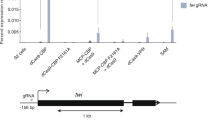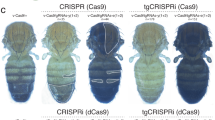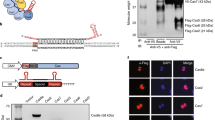Abstract
We show that convergent transcription induces transcriptional gene silencing (TGS) in trans for both fission yeast and mammalian cells. This method has advantages over existing strategies to induce gene silencing. Previous studies in fission yeast have characterized TGS as a cis-specific process involving RNA interference that maintains heterochromatic regions such as centromeres. In contrast, in mammalian cells, gene silencing is known to occur through a post-transcriptional mechanism that uses exogenous short interfering RNAs or endogenous microRNAs to inactivate mRNA. We now show that the introduction of convergent transcription plasmids into either Schizosaccharomyces pombe or mammalian cells allows the production of double-stranded RNA from inserted gene fragments, resulting in TGS of endogenous genes. We predict that using convergent transcription to induce gene silencing will be a generally useful strategy and allow for a fuller molecular understanding of the biology of TGS.
This is a preview of subscription content, access via your institution
Access options
Subscribe to this journal
Receive 12 print issues and online access
$189.00 per year
only $15.75 per issue
Buy this article
- Purchase on Springer Link
- Instant access to full article PDF
Prices may be subject to local taxes which are calculated during checkout







Similar content being viewed by others
References
Grewal, S.I. RNAi-dependent formation of heterochromatin and its diverse functions. Curr. Opin. Genet. Dev. 20, 134–141 (2010).
Baulcombe, D. RNA silencing in plants. Nature 431, 356–363 (2004).
Bartel, D.P. MicroRNAs: target recognition and regulatory functions. Cell 136, 215–233 (2009).
Verdel, A., Vavasseur, A., Le Gorrec, M. & Touat-Todeschini, L. Common themes in siRNA-mediated epigenetic silencing pathways. Int. J. Dev. Biol. 53, 245–257 (2009).
Carthew, R.W. & Sontheimer, E.J. Origins and mechanisms of miRNAs and siRNAs. Cell 136, 642–655 (2009).
Hutvagner, G. & Simard, M.J. Argonaute proteins: key players in RNA silencing. Nat. Rev. Mol. Cell Biol. 9, 22–32 (2008).
Bühler, M. & Moazed, D. Transcription and RNAi in heterochromatic gene silencing. Nat. Struct. Mol. Biol. 14, 1041–1048 (2007).
Gullerova, M. & Proudfoot, N.J. Cohesin complex promotes transcriptional termination between convergent genes in S. pombe. Cell 132, 983–995 (2008).
Gullerova, M., Moazed, D. & Proudfoot, N.J. Autoregulation of convergent RNAi genes in fission yeast. Genes Dev. 25, 556–568 (2011).
Gu, S.G. et al. Amplification of siRNA in Caenorhabditis elegans generates a transgenerational sequence-targeted histone H3 lysine 9 methylation footprint. Nat. Genet. 44, 157–164 (2012).
Kavi, H.H., Fernandez, H., Xie, W. & Birchler, J.A. Genetics and biochemistry of RNAi in Drosophila. Curr. Top. Microbiol. Immunol. 320, 37–75 (2008).
Wang, Z., Morris, J.C., Drew, M.E. & Englund, P.T. Inhibition of Trypanosoma brucei gene expression by RNA interference using an integratable vector with opposing T7 promoters. J. Biol. Chem. 275, 40174–40179 (2000).
Alibu, V.P., Storm, L., Haile, S., Clayton, C. & Horn, D. A doubly inducible system for RNA interference and rapid RNAi plasmid construction in Trypanosoma brucei. Mol. Biochem. Parasitol. 139, 75–82 (2005).
Shi, H. et al. Genetic interference in Trypanosoma brucei by heritable and inducible double-stranded RNA. RNA 6, 1069–1076 (2000).
Giordano, E., Rendina, R., Peluso, I. & Furia, M. RNAi triggered by symmetrically transcribed transgenes in Drosophila melanogaster. Genetics 160, 637–648 (2002).
Tran, N., Cairns, M.J., Dawes, I.W. & Arndt, G.M. Expressing functional siRNAs in mammalian cells using convergent transcription. BMC Biotechnol. 3, 21 (2003).
Clemens, M.J. PKR—a protein kinase regulated by double-stranded RNA. Int. J. Biochem. Cell Biol. 29, 945–949 (1997).
Jin, J., Cid, M., Poole, C.B. & McReynolds, L.A. Protein mediated miRNA detection and siRNA enrichment using p19. Biotechniques 48, xvii–xxiii (2010).
Simmer, F. et al. Hairpin RNA induces secondary small interfering RNA synthesis and silencing in trans in fission yeast. EMBO Rep. 11, 112–118 (2010).
Urosevic, N. Is flavivirus resistance interferon type I-independent? Immunol. Cell Biol. 81, 224–229 (2003).
Bridge, A.J., Pebernard, S., Ducraux, A., Nicoulaz, A.L. & Iggo, R. Induction of an interferon response by RNAi vectors in mammalian cells. Nat. Genet. 34, 263–264 (2003).
Haussecker, D. & Proudfoot, N.J. Dicer-dependent turnover of intergenic transcripts from the human β-globin gene cluster. Mol. Cell Biol. 25, 9724–9733 (2005).
Sinkkonen, L., Hugenschmidt, T., Filipowicz, W. & Svoboda, P. Dicer is associated with ribosomal DNA chromatin in mammalian cells. PLoS ONE 5, e12175 (2010).
Cobb, B.S. et al. T cell lineage choice and differentiation in the absence of the RNase III enzyme Dicer. J. Exp. Med. 201, 1367–1373 (2005).
Premsrirut, P.K. et al. A rapid and scalable system for studying gene function in mice using conditional RNA interference. Cell 145, 145–158 (2011).
Schönborn, J. et al. Monoclonal antibodies to double-stranded RNA as probes of RNA structure in crude nucleic acid extracts. Nucleic Acids Res. 19, 2993–3000 (1991).
Schmitter, D. et al. Effects of Dicer and Argonaute down-regulation on mRNA levels in human HEK293 cells. Nucleic Acids Res. 34, 4801–4815 (2006).
Maida, Y. & Masutomi, K. RNA-dependent RNA polymerases in RNA silencing. Biol. Chem. 392, 299–304 (2011).
Bühler, M., Verdel, A. & Moazed, D. Tethering RITS to a nascent transcript initiates RNAi- and heterochromatin-dependent gene silencing. Cell 125, 873–886 (2006).
Iida, T., Nakayama, J. & Moazed, D. siRNA-mediated heterochromatin establishment requires HP1 and is associated with antisense transcription. Mol. Cell 31, 178–189 (2008).
Shinagawa, T. & Ishii, S. Generation of Ski-knockdown mice by expressing a long double-strand RNA from an RNA polymerase II promoter. Genes Dev. 17, 1340–1345 (2003).
Nejepinska, J. et al. dsRNA expression in the mouse elicits RNAi in oocytes and low adenosine deamination in somatic cells. Nucleic Acids Res. 40, 399–413 (2012).
Morris, K.V., Chan, S.W., Jacobsen, S.E. & Looney, D.J. Small interfering RNA-induced transcriptional gene silencing in human cells. Science 305, 1289–1292 (2004).
Seila, A.C. et al. Divergent transcription from active promoters. Science 322, 1849–1851 (2008).
Core, L.J. & Lis, J.T. Transcription regulation through promoter-proximal pausing of RNA polymerase II. Science 319, 1791–1792 (2008).
Preker, P. et al. RNA exosome depletion reveals transcription upstream of active human promoters. Science 322, 1851–1854 (2008).
Janowski, B.A. & Corey, D.R. Inhibiting transcription of chromosomal DNA using antigene RNAs. Nucleic Acids Symp. Ser. (Oxf) 49, 367–368 (2005).
Janowski, B.A. et al. Activating gene expression in mammalian cells with promoter-targeted duplex RNAs. Nat. Chem. Biol. 3, 166–173 (2007).
Yue, X. et al. Transcriptional regulation by small RNAs at sequences downstream from 3′ gene termini. Nat. Chem. Biol. 6, 621–629 (2010).
Alló, M. et al. Control of alternative splicing through siRNA-mediated transcriptional gene silencing. Nat. Struct. Mol. Biol. 16, 717–724 (2009).
Tufarelli, C. et al. Transcription of antisense RNA leading to gene silencing and methylation as a novel cause of human genetic disease. Nat. Genet. 34, 157–165 (2003).
Carlile, M. et al. Strand selective generation of endo-siRNAs from the Na/phosphate transporter gene Slc34a1 in murine tissues. Nucleic Acids Res. 37, 2274–2282 (2009).
Fukagawa, T. et al. Dicer is essential for formation of the heterochromatin structure in vertebrate cells. Nat. Cell Biol. 6, 784–791 (2004).
Clemens, M.J. & Elia, A. The double-stranded RNA-dependent protein kinase PKR: structure and function. J. Interferon Cytokine Res. 17, 503–524 (1997).
Ashe, H.L., Monks, J., Wijgerde, M., Fraser, P. & Proudfoot, N.J. Intergenic transcription and transinduction of the human β-globin locus. Genes Dev. 11, 2494–2509 (1997).
Mattick, J.S. The genetic signatures of noncoding RNAs. PLoS Genet. 5, e1000459 (2009).
Tam, O.H. et al. Pseudogene-derived small interfering RNAs regulate gene expression in mouse oocytes. Nature 453, 534–538 (2008).
Werner, A. & Sayer, J.A. Naturally occurring antisense RNA: function and mechanisms of action. Curr. Opin. Nephrol. Hypertens. 18, 343–349 (2009).
Faghihi, M.A. & Wahlestedt, C. Regulatory roles of natural antisense transcripts. Nat. Rev. Mol. Cell Biol. 10, 637–643 (2009).
Kaneko, H. et al. DICER1 deficit induces Alu RNA toxicity in age-related macular degeneration. Nature 471, 325–330 (2011).
Giles, K.E., Ghirlando, R. & Felsenfeld, G. Maintenance of a constitutive heterochromatin domain in vertebrates by a Dicer-dependent mechanism. Nat. Cell Biol. 12, 94–99 (2010).
Turner, A.M. & Morris, K.V. Controlling transcription with noncoding RNAs in mammalian cells. Biotechniques 48, ix–xvi (2010).
Acknowledgements
We thank T. Gligoris for advice and encouragement, E. White for help with HeLa cell culture and J. Monks for cloning. This work was supported by grants from Cancer Research UK and the Wellcome Trust to N.J.P. and by L'Oreal/UNESCO woman in science UK and Ireland award to M.G.
Author information
Authors and Affiliations
Contributions
M.G. performed all the experimental analyses. M.G. and N.J.P. designed the experiments and wrote the manuscript.
Corresponding authors
Ethics declarations
Competing interests
Convergent transcription–mediated TGS as described in these studies is the subject of worldwide patent WO/2012/114111 held by ISIS Innovation of Oxford University.
Supplementary information
Supplementary Text and Figures
Supplementary Figures 1–5 (PDF 300 kb)
Rights and permissions
About this article
Cite this article
Gullerova, M., Proudfoot, N. Convergent transcription induces transcriptional gene silencing in fission yeast and mammalian cells. Nat Struct Mol Biol 19, 1193–1201 (2012). https://doi.org/10.1038/nsmb.2392
Received:
Accepted:
Published:
Issue Date:
DOI: https://doi.org/10.1038/nsmb.2392
This article is cited by
-
Identification of cell-type specific alternative transcripts in the multicellular alga Volvox carteri
BMC Genomics (2023)
-
A lentiviral vector for the production of T cells with an inducible transgene and a constitutively expressed tumour-targeting receptor
Nature Biomedical Engineering (2023)
-
Chromatin-based mechanisms to coordinate convergent overlapping transcription
Nature Plants (2021)
-
Production of small RNAs by mammalian Dicer
Pflügers Archiv - European Journal of Physiology (2016)
-
Human nuclear Dicer restricts the deleterious accumulation of endogenous double-stranded RNA
Nature Structural & Molecular Biology (2014)



